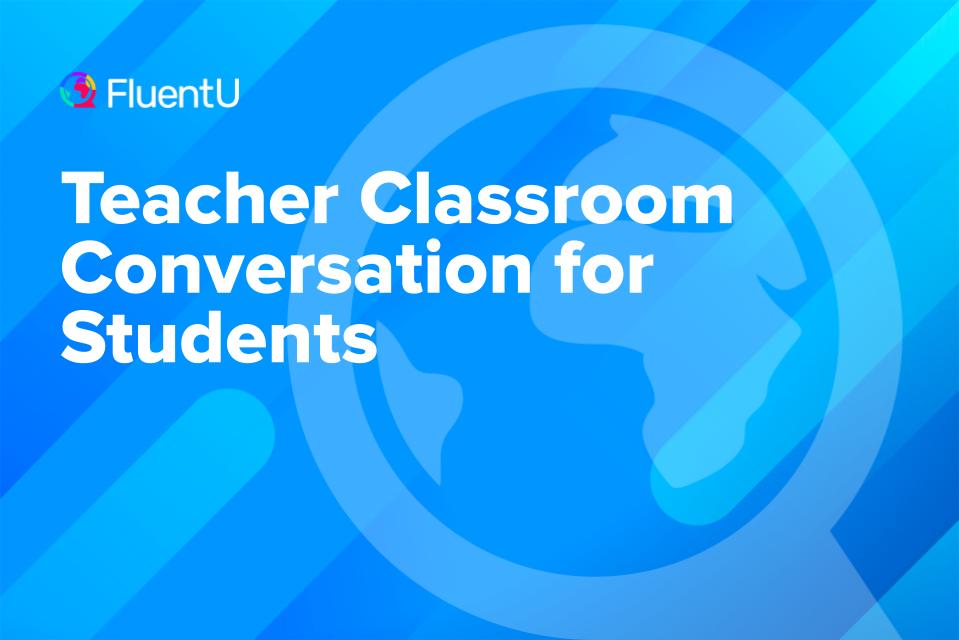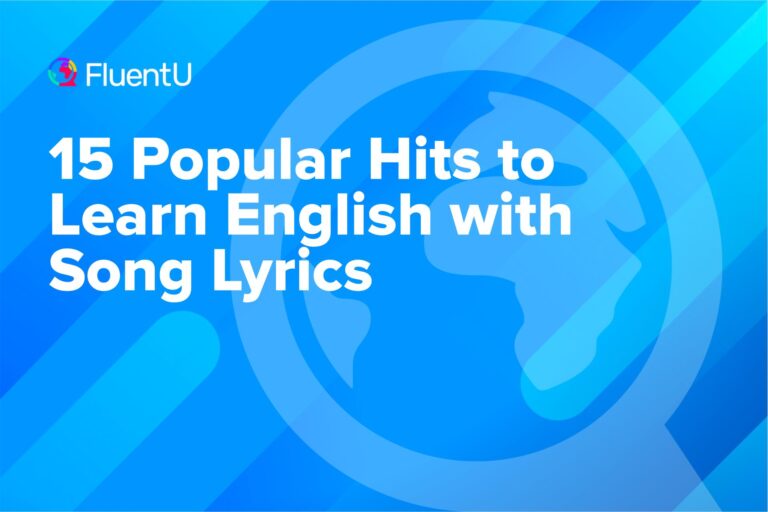Teacher Classroom Conversation for Students

The way you speak to a friend in a coffee shop is very different than the way you speak with a teacher in a classroom. Between different vocabulary and different etiquette, it can feel overwhelming at times.
I am going to teach you all the basics of talking to your teacher. By the end of this post, you will feel comfortable carrying on a classroom conversation in English.
Download: This blog post is available as a convenient and portable PDF that you can take anywhere. Click here to get a copy. (Download)
How to Talk to Teachers
In general, the relationship between a student and a teacher is formal. When addressing a teacher, students need to be respectful and polite by using titles similar to what you would use in the workplace, as outlined in this video:
It is important to know the teacher’s title so you know the correct way to address them. On the first day of class, most teachers will introduce themselves and write their name on the board. At this point, you will know how to address the teacher. However, if you are ever in doubt, it is best to address the teacher formally by calling them Mr./Mrs./Miss. + Last Name.
Some teachers prefer to be addressed as Professor + Last Name or Dr. + Last Name if this title applies.
Besides understanding how to address the teacher, students also need to learn the rules for talking in their classroom. Different teachers use different rules, but you might have to raise a hand before speaking, wait until class ends to hold a conversation or send an email if you have a question.
Once you know these classroom rules and the appropriate way to address your teacher, you will be ready to actually hold a conversation with them.
Conversations Between Teachers and Students
Now that you understand the basics, let’s look at some example conversations between teachers and students.
Take some time to watch each of these five videos. You will hear conversations and learn new vocabulary. After each video, we will take a deeper look at the conversations together.
You can watch all these videos on YouTube, but to help you learn the conversations and vocabulary easier, you can also find some of videos and clips like them on FluentU.
FluentU takes authentic videos—like music videos, movie trailers, news and inspiring talks—and turns them into personalized language learning lessons.
You can try FluentU for free for 2 weeks. Check out the website or download the iOS app or Android app.
P.S. Click here to take advantage of our current sale! (Expires at the end of this month.)

Now, class is in session! Let’s get to it.
“Teacher Time”
This video is the perfect place for new English learners to start. You will hear a few phrases that teachers often say to students. Write down any words that are new to you and practice repeating each phrase after you hear it in the video.
A few key vocabulary words and phrases from this video are:
- repeat — say again
- open your books — a phrase encouraging someone to take out a book and turn to a specific page
- listen — pay attention to sound
Let’s look at a sample conversation using some of the phrases from the video:
This example shows how a teacher could talk to students about the lesson for the day. The vocabulary words in this video are great building blocks for more complex conversations that are often heard in classrooms.
Here is a sample dialogue that uses the vocabulary words from the video:
Teacher: “Come in students, sit down.”
Student: “What are we learning today?”
Teacher: “Today we are learning about apples. Please, open your books and read page 3.”
Teacher: “Now, listen to me say ‘apple’ and repeat after me.”
Student: “Apple.”
Teacher: “Now write the word ‘apple’ on your paper.”
Teacher: “Very good. You may now go out and play.”
“Being Polite”
It is important to be polite, especially when you are talking to your teacher. Watch this video for examples of how to have a polite conversation. Many of the phrases in this video also apply to conversations held outside of a school setting.
A few key vocabulary phrases from this video are:
- this is difficult — a phrase that means “this is hard or challenging”
- going to school — a phrase that means someone is on their way to the educational building
- thank you for helping — a phrase expressing gratitude for someone’s assistance
Let’s look at some of the short conversations from the video:
You might hear this short conversation when a student arrives in the classroom. Notice how the student responds in a polite manner.
Teacher: “Please come in.”
Student: “Thank you very much.”
This conversation could happen after a student asks for help with a math problem. Again, the student is polite and thanks the teacher in the conversation.
Student: “Thank you for helping.”
Teacher: “No problem.”
“First Day of School”
The first day of school can be hard, but this video shows how to handle a conversation between a teacher and a new student. Pay attention to how the teacher talks to the class and how the new student introduces herself.
A few key vocabulary phrases from this video are:
- my name is — a phrase used to introduce yourself
- come in — a phrase inviting someone to enter a space
- sit down — a phrase encouraging someone to rest on a chair
Listen to the conversation in this video. The students greet the teacher and they ask how the teacher is doing. A new student also enters the classroom and meets the rest of the class.
This is another great example of being polite in the classroom.
Students: “Good morning.”
Teacher: “Good morning, everyone”
Students: “How are you?”
Teacher: “Fine thanks, how are you?”
Students: “Great!”
Teacher: “Come in please.”
New Student: “Nice to meet you. My name is Kate.”
Students: “Nice to meet you, too. Sit down, please.”
New Student: “Thank you.”
“In School”
This video covers some vocabulary words you will hear in a classroom. Repeat the words after you hear them in the video.
A few key vocabulary words from this video are:
- backpack — a bag for carrying items on your back
- colored pencil — art instrument with a colorful wax core
- locker — a compartment that is used for individual storage and can be locked
Let’s look at a sample conversation using some of the phrases from the video: In this scenario, we are going to pretend that the students put all of their backpacks in a pile before going to recess. When it is time to go back inside, the teacher tries to hand out the backpacks to the correct students.
Teacher: “Recess is over. Please pick up your backpack from me and get in line.”
Student: “May I please get my backpack?”
Teacher: “Which one is your backpack?”
Student: “My backpack is red.”
Teacher: “Here you go.”
Student: “Thank you.”
In another scenario, the students are in an art class. The teacher asks them to make a self-portrait.
Teacher: “Today I would like you to use any materials you have to make a self-portrait.”
Student: “I have many colored pencils.”
Teacher: “Colored pencils are perfect.”
Student: “Can I use crayons?”
Teacher: “Crayons are also great for this project.”
“Harry Potter and the Chamber of Secrets”
This clip from “Harry Potter and the Chamber of Secrets” is not a FluentU video, but you can still learn a lot from it! It is perfect for intermediate and advanced English learners.
In this scene, you will hear Professor McGonagall speak to her class about their lesson and the mysterious chamber of secrets. Be aware that since this is at a school for witches and wizards, some of the phrases are magical spells and are not in English. Focus on the way the students speak to their professor and the advanced vocabulary words used during the clip.
A few key vocabulary words from this video are:
Let’s look at some of the conversations in this video.
First, notice how Professor McGonagall starts the class. She quiets the room and explains the lesson for the day.
Professor: “Could I have your attention, please. Today we will be transforming animals into water goblets.”
Later in the clip, a student named Hermione Granger raises her hand to ask a question. Notice how Professor McGonagall also addresses the student in a formal manner. This is not always common but it is a sign of mutual respect.
Professor: “Yes Miss Granger.”
Student: “Professor, I was wondering if you could tell us about the chamber of secrets?”
Professor: “Very well.”
English conversations only get better with practice. Write out your own sample classroom conversation in English or use what you’ve learned to start practicing.
Remember, it is fine to not be perfect right away. Fluency is a journey and you are on your way to learning how to have polite conversations with a teacher in English.
And One More Thing...
If you like learning English through movies and online media, you should also check out FluentU. FluentU lets you learn English from popular talk shows, catchy music videos and funny commercials, as you can see here:
The FluentU app and website makes it really easy to watch English videos. There are captions that are interactive. That means you can tap on any word to see an image, definition, and useful examples.
For example, when you tap on the word "searching," you see this:
Learn all the vocabulary in any video with quizzes. Swipe left or right to see more examples for the word you’re learning.

FluentU helps you learn fast with useful questions and multiple examples. Learn more.
The best part? FluentU remembers the vocabulary that you’re learning. It gives you extra practice with difficult words—and reminds you when it’s time to review what you’ve learned. You have a truly personalized experience.
Start using the FluentU website on your computer or tablet or, better yet, download the FluentU app from the iTunes or Google Play store. Click here to take advantage of our current sale! (Expires at the end of this month.)










